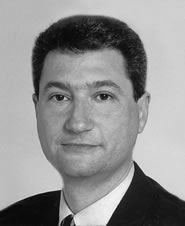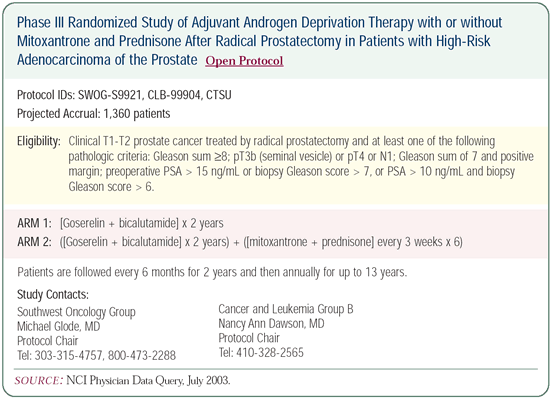 Home: PCU
4|2003: Robert Dreicer, MD, FACP Home: PCU
4|2003: Robert Dreicer, MD, FACP
 |
|
Robert
Dreicer, MD, FACP |
| |
| |
Director, Genitourinary Medical Oncology
Associate Director, Experimental Therapeutics
Taussig Cancer Center
Cleveland Clinic Foundation |
Edited comments by Dr Dreicer
Case study: Biochemical recurrence postprostatectomy
History
This patient had a screening PSA of 4.5 ng/mL when he was in
his mid-50s, and he was referred to a urologist who diagnosed clinical
T1c, Gleason 3+4 prostate cancer. When he underwent radical prostatectomy,
he was found to have pathologically organ-confined disease. He
did well for a couple of years. About one year ago, he had evidence
of biochemical failure and a PSA of 0.2 ng/mL. A month later, a
repeat PSA was 0.3 ng/mL.
Follow-up
The patient’s postsurgical sexual functioning was normal;
occasionally he used sildenafil. Ultimately, he opted to go to
another institution for a second opinion, where he was started
on 50 mg of bicalutamide as monotherapy. There was some decrease
in erectile function associated with the bicalutamide; he used
a little more sildenafil and was able to function. He also had
some gynecomastia, which was uncomfortable. Other than that, he
was a bit more fatigued, but he wasn’t sure whether the fatigue
was related to the therapy or the anxiety associated with the relapse.
He responded to bicalutamide 50 mg for a few months, but then
his PSA began to rise. He was referred back to me, and we discontinued
the bicalutamide hoping that he might manifest an antiandrogen
withdrawal response.
Six weeks later, we repeated his PSA and it was rising. Because
of his exposure to bicalutamide, he was not a candidate for our
available clinical trials. We were left with the options of hormonal
therapy with an LHRH agonist or expectant management. His PSA doubling
time was now about four months. Ultimately, he decided to initiate
LHRH therapy. Despite making three appointments to receive his
LHRH, he has not yet shown up.
Case discussion
This patient’s postprostatectomy risk of biochemical recurrence
was probably about 30 percent. There is emerging evidence that
a Gleason 3+4 lesion is a different entity than a Gleason 4+3 cancer.
The newer Partin tables are beginning to take that into account.
If he had a Gleason 4+3 cancer, I suspect his risk of biochemical
recurrence would have been five or ten percent higher.
When he initially came to see me, we discussed the natural history
of the disease and reviewed the Pound data from Hopkins about time
to failure and death. We also talked about therapeutic options.
At the time, we were between studies and didn’t have an open
clinical trial.
I reviewed the controversies over early versus delayed hormonal
therapy, and we discussed the role of salvage radiation therapy.
I recommended radiation therapy, even though it had been about
a year and a half since his surgery. It was still reasonable to
consider radiation therapy in this setting, but the patient opted
not to pursue this therapy. He obtained a second opinion and was
again counseled to consider radiation therapy.
I told him if he was not going to have radiation therapy, the
issue of early versus delayed hormonal therapy was controversial,
and my standard practice was not to utilize early hormonal therapy.
If his PSA doubling time were to shorten, I would certainly consider
early hormonal therapy for him; however, I would have discussed
primary therapy with an LHRH as a more favorable option. The physician
from whom he obtained a second opinion offered similar information,
but that individual was more willing to use alternative forms of
hormonal therapy, and the patient was started on bicalutamide 50
mg.
Because I care for a large number of patients on hormonal therapy,
I look at the debate over early versus delayed hormonal therapy
with great respect for the side-effect profile of androgen deprivation.
I discuss the litany of major side effects that a subset of patients
will complain about, including cognitive dysfunction, weight gain,
fatigue, sexual dysfunction, hot flashes and osteoporosis.
Early versus delayed hormonal therapy in patients
with biochemical relapse
The debate over early versus delayed hormonal therapy comes down
to perspective. No advocate on either side of the argument can
point to the literature with absolute certainty. It’s difficult
to apply the information in the literature to a subset of patients
with a different stage of disease.
Additionally, the therapy has very significant ramifications
for the patients; these are not benign therapies. I tend to approach
medicine as a therapeutic nihilist. I cannot, in good conscience,
recommend a therapy that may cause significant quality-of-life
alterations, in the absence of definitive evidence that it will
prolong life expectancy.
No study of hormonal therapy has been completed in patients with
biochemical relapse. We are extrapolating the findings from the
Bolla, ECOG and MRC trials, which included patients with locally
advanced or metastatic disease. That may ultimately be a rational
thing to do, but in medicine, we have learned that it doesn’t
always turn out the way we think it will.
It is not absolutely clear whether we change clinical progression
with early hormonal therapy. There are multiple criticisms of the
MRC trial, including Pat Walsh’s criticism that the hormonal
therapy administration in the delayed group of the MRC trial has
no correlation to the practice in the United States. These patients
were not treated until they had overt, clinical evidence of metastatic
disease and in some cases, not even then.
Clearly, in the United States, hormonal therapy is not delayed
until patients have extremely advanced disease. If you opt to follow
a patient with early biochemical failure expectantly, you must
watch them carefully.
If their PSA doubling time goes from 14 months to four months,
they are more likely to be treated at that juncture than to wait
until they have spinal cord compression. Hence, early versus delayed
is a continuum.
Ongoing adjuvant chemotherapy trials
All of us understand that there are subsets of patients who are
at risk and that we need to address systemic failure. Several ongoing
trials, including an Intergroup adjuvant trial, the SWOG trial
and an industry-sponsored Phase II trial, are evaluating adjuvant
chemotherapy.
Some of the adjuvant trials have hormonal therapy as the control
arm. The SWOG trial has two treatment arms. We wanted to compare
adjuvant therapy to no treatment, but we also recognized that doing
trials like that in the United States is not practical in this
era. Therefore, patients are randomized to two years of combined
androgen ablation with or without six cycles of mitoxantrone and
prednisone.
Unfortunately, that trial is having difficulty accruing patients,
in part because the protocol was designed to evaluate the best
chemotherapy regimen at that time. Most medical oncologists feel
that it’s not as active as some other therapies now available.
Another trial currently being conducted at selected sites around
the country is evaluating single-agent docetaxel in patients with
a 50 percent risk of failure at three years. The trial has been
accruing relatively well at six or seven sites.


Adjuvant androgen deprivation in patients with
positive nodes
The Eastern Cooperative Oncology Group (ECOG) trial demonstrated
a survival advantage for adjuvant androgen deprivation and an unpublished,
ongoing European trial, using a similar trial design has not yet
been reported. One can argue about the results of the ECOG trial,
but it was a Phase III trial. I believe a patient with positive
nodes represents a somewhat different dynamic on the continuum
than a patient who is three years postprostatectomy, and has biochemical
failure. Over the last two years, approximately one-half of my
patients with positive nodes have opted to initiate adjuvant hormonal
therapy.
Case study: 74-year-old man with spinal cord
compression
History
This man had a radical prostatectomy for a Gleason 7 tumor at
another institution about three years prior to his presentation.
His PSA was undetectable after surgery, and he had not obtained
any follow-up for approximately 18 months.
He presented with severe back pain and had a T8 cord compression
on MRI. He was hospitalized, started on steroids and underwent
radiation therapy. After the radiation therapy, a bone scan showed
only one metastatic site, and his PSA was about 300 ng/mL. He was
started on hormonal therapy and his PSA declined.
Follow-up and discussion
It is uncommon, but not rare, for metastatic disease to present
so quickly after a successful prostatectomy. In retrospect, the
patient probably had a Stage C, Gleason 7 tumor.
He received hormonal therapy over the next 18 months, and then
developed a second spinal cord compression. He also developed nodal
and pulmonary metastases. At that juncture, he received radiation
therapy again for the second spinal cord lesion. He did remarkably
well in terms of function, however, he required opiates to control
pain and he lost 25 pounds.
He enrolled in a clinical trial evaluating docetaxel and an investigational
agent, PS-341 (VelcadeTM [bortezomib]) and he had a very dramatic
response. Bortezomib is the first in a novel class of agents called
proteasome inhibitors. This patient was part of an investigational
trial that was based on evidence that bortezomib has single-agent
activity. Bortezomib is in development and the trial is ongoing.
This patient responded clinically after about three weeks. His
appetite improved and his pain and opiate requirements decreased.
He was receiving an active chemotherapy drug, and I don’t
know whether the investigational drug added anything. This is the
kind of response that a subset of patients with symptomatic advanced
prostate cancer receives from chemotherapy.
He had a window of three and a half to four months in which his
quality of life dramatically improved, and he actually became opioid-free
with only mild discomfort in the site of the original cord compression.
Unfortunately, his disease progressed and he faired poorly. I did
not treat him with systemic agents again. His performance status
declined, and I converted our approach to a supportive care mode — opiates,
additional radiation therapy and hospice. He passed away a short
time ago.
Select publications
|